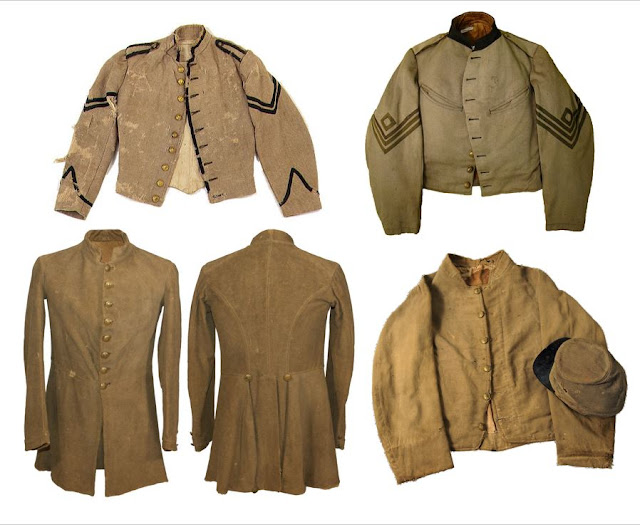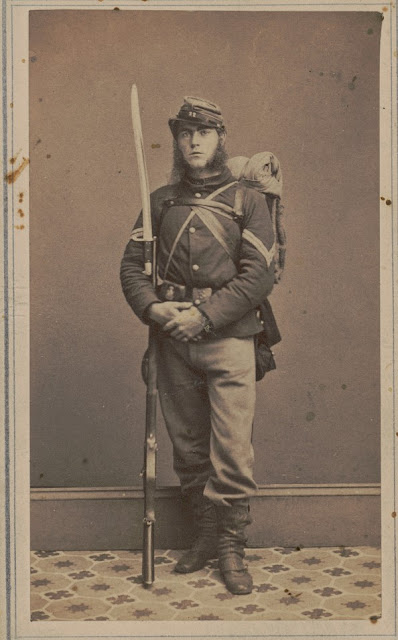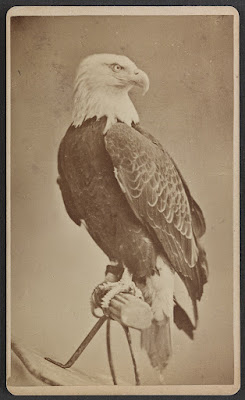Into the Wilderness with the 122nd Ohio
Corporal Charles Willey of the 122nd Ohio sustained the second and third of his four wartime wounds when his regiment charged the Confederate line during the last day of the Battle of the Wilderness. Located on the far right of the Union line, the Ohioans charged the works held by John Pegram's Virginia brigade.
Corporal Willey’s account of the Battle of Wilderness first saw publication in the June 2, 1864, edition of the Zanesville Daily Courier. In this charge, the 122nd Ohio lost 120 men.
U.S. General
Hospital, Annapolis, Maryland
May 26, 1864
I thought you would like to have some
account of our movements from the time of leaving our winter quarters. We
started on the morning of May 4th and that evening crossed the
Rapidan and camped. The morning of the 5th we took up the line of
march, moving in the direction of the old Wilderness Tavern, our corps moving
on one road. Going some 4 or 5 miles, we were ordered back to where we had
camped the night before. About an hour after we got there we were ordered to
move forward again. This time we went almost to the tavern and then were
ordered back to a road that led into the Wilderness on the extreme right of our
line of battle. We were drawn up in line of battle and lay there some 2-3 hours
then were relieved by a brigade of Burnside’s corps.
Our brigade went further to the left
in a position to support a brigade that was engaged. We were under fire until
the fighting stopped at about 9 o’clock that night. Then our company with some
others was ordered out to picket in front of the regiment. We were within
speaking distance of the Rebels and we had to keep a sharp lookout while they
did the same. There was picket firing all night but it did not amount to much.
The Rebs were cutting down trees and building breastworks all night and worked
as if for life. We could hear them plainly but could not see them.
On the morning of the 6th
our brigade made a charge on the Rebel works. They held their fire until we
were about 100 yards from them. When they opened on us, such a sight I never
want to see again. It seemed as if every other man had fallen, either killed or
wounded. It was terrible to see the brave boys falling on every side. I had
fired but a few shots when a ball came through my haversack, striking me on the
hip. I first thought I was badly wounded but I found I was only bruised. In a
short time, another ball struck me on the left leg just above the knee and
about two inches from the wound I received at Winchester. The ball did not bury
itself in the flesh and I took it out myself. However, it affected the old
wound so much that I was quite lame.
"An assault was ordered at daylight but from some cause was not made until about 9 a.m., the 122nd being on the left of our brigade and by some mistake unsupported by any second line. The order being to press on without firing, our regiment moved at a run without any caps on their guns and were pushing for the enemy's works when troops on both right and left of us began firing and laying down. I then ordered my wing of the regiment to lie down and suppose Colonel Ball did the same with his wing. Firing from our lines began, our regimental colors being nearer the Rebel works than any other part of the line. After half an hour or more, the troops on our right began to fall back as did those on our left and then did the 122nd Ohio, having suffered heavily. Thus the assault was a failure." ~ Lieutenant Colonel Moses M. Granger, 122nd Ohio
When I was wounded, I was beside Andrew
Voll; he had not been touched when I left. The wounded bots that came to the
rear after I did said they saw Voll, Frost, and Sloan fall before they left. I saw
a great many fall but could not tell who they were as they generally fell on
their faces. When I started to the rear, I thought the balls came as thick as
they did in the front and the shells were worse. We passed over the ground
where they had fought on the 5th there was quite a number of Rebel
dead scattered through the woods with some of our own men. In some places, the
Rebel dead lay in heaps. It was a sad sight to see men lying there where their
friends will never find them, will not even know what their fate was. Many of
the wounded that were not able to get away perished in the flames in the
Wilderness. The fire was caused by shells exploding among the dry leaves.
When we got out of range of the balls
and shells we found the field hospital where the surgeons were dressing wounds
as fast as possible and sending the wounded to the brigade hospitals. Our
hospital was at the old Wilderness tavern. That night, orders came to move the
hospitals as it was thought that would be the battleground the next day. All
that were able had to walk while the others were placed in ambulances. The
train was some 3 miles long.
On the 7th we arrived at
the Chancellorsville battlefield where we stopped awhile expecting to go on
through to Rappahannock Station on the Alexandria Railroad but something
prevented us from moving. On the morning of the 8th, we started in
the direction of Spotsylvania but could not get through that way; we were then
turned back on to the plank road leading to Fredericksburg. The train moved
very slow and we traveled all night, reaching Fredericksburg at noon on the 9th.
Every house, church, and yard that could be used for that purpose were taken as
hospitals and almost everywhere on the streets you could see wounded men glad
to lie down quietly after their painful ride. Everything was done that possibly
could be and great praise is due to Dr. Bryan, Chaplain Houston of our regiment
and Mr. Tucker, our hospital steward. They went with us to Fredericksburg and
were busy night and day attending to the sufferers, making them as comfortable
as possible with the scanty means they had for supplies were getting low.
On May 10th all that were
able to travel were directed to Belleplain Landing. We crossed the Rappahannock
and took the road leading to the landing which is distant 8 miles. Belleplain
Landing is on the Potomac and there we found the Sanitary and Christian
Commissions doing all they could to relieve the sufferers. About midnight, the
boat came to take us to Washington where we arrived on the 11th and
were immediately taken to the hospital where we were fed and got clean clothes.
We left there on the 18th and went to Baltimore to take a boat for
Annapolis where we arrived on the morning of the 19th.
I am doing very well but I do not think I will be able to march. Concerning Robert Sloan, I know nothing only that he was reported killed. Voll and Frost the same. I presume you have particulars before this. We have everything here that we need.
To learn more about the Battle of the Wilderness, please check out these posts:
Coming Out with a Whole Hide: A Sharpshooter Describes the Wilderness
Grant the Great will be no more: An Alabamian at Wilderness and Spotsylvania Courthouse
Sources:
Letter from Corporal Charles Tatman Willey, Co. A, 122nd Ohio Volunteer Infantry, Zanesville Daily Courier (Ohio), June 2, 1864, pg. 2
Letter from
Lieutenant Colonel Moses Moorhead Granger, 122nd Ohio Volunteer Infantry, Zanesville
Daily Courier (Ohio), May 25, 1864, pg. 2











Comments
Post a Comment